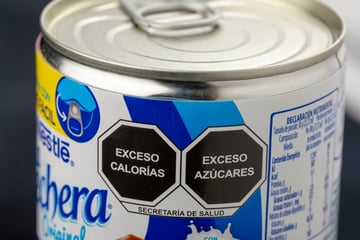How you calculate Calories for your food product depends largely on where you will sell your product and the laws governing the food labeling in that country or region. This blog will cover the Calorie calculation methods used in the U.S., Canada, Mexico, and the European Union.
Calorie Calculations in the United States
In the U.S., there are six accepted methods. The two most frequently used are the 4-4-9 formula and the Atwater method.
- 4-4-9. In the U.S., most manufacturers use the 4-4-9 method, which assumes that each gram of protein contributes 4 Calories to the caloric total, each gram of carbohydrates contributes 4 Calories, and each gram of fat contributes 9 Calories.
- Atwater. The USDA SR database, in contrast, commonly uses the Atwater method. The Atwater method uses more precise figures based on food type when assigning Calories values per gram to protein, carbohydrate, and fat. View our online Atwater table to see it in action.
- 4-4-9 adjusted for non-digestible carbohydrates and sugar alcohols. (Total carbohydrates less non-digestible carbs and sugar alcohols.) For soluble non-digestible carbohydrates, a factor of 2 Calories per gram (rather than 4) is used, and sugar alcohols use specific factors listed in No. 6 below.
- Specific food factors approved by the FDA.
- Bomb calorimetry. This process involves burning a food item to see how much heat it releases, which is directly convertible to Calories since, as we know, one Calorie equals the amount of energy required to heat one kilogram of water by one degree Celsius. Note the adjustment for Calories from protein in the CFR.
- General factors for caloric value of sugar alcohols: Isomalt = 2.0 Calories per gram, lactitol = 2.0 Calories per gram, xylitol = 2.4 Calories per gram, maltitol = 2.1 Calories per gram, sorbitol = 2.6 Calories per gram, hydrogenated starch hydrolysates = 3.0 Calories per gram, mannitol = 1.6 Calories per gram, and erythritol = 0 Calories per gram.
For more information, see the U.S. food labeling regulations, Title 21, in the National Archives.
Calorie Calculations in Canada
- Atwater method. Our online Atwater table breaks down how to calculate calories based on ingredients.
- 4-4-9-7. Canada also uses a Calorie averaging method, which is the same concept as the U.S. 4-4-9 method but with the addition of alcohol and including values for kilojoules. Each gram of protein equals 4 Calories (17 kJ), each gram of carbohydrate equals 4 Calories (17 kJ), each gram of fat equals 9 Calories (37 kJ) and each gram of alcohol equals 7 Calories (29 kJ).
- General factors for caloric value of sugar alcohols, glycerol and polydextrose: Isomalt = 2.0 Calories per gram, lactitol = 2.0 Calories per gram, xylitol = 3.0 Calories per gram, maltitol = 3.0 Calories per gram, sorbitol = 2.6 Calories per gram, mannitol = 1.6 Calories per gram, and erythritol = 0.2 Calories per gram, glycerol = 4.32 Calories per gram, and polydextrose = 1 Calorie per gram.
- 4-4-9-7 adjusted for fibre. A value of 2 Calories (8 kJ) per gram should be used for the dietary fibre portion of the fibre source. A value of less than 2 Calories (8 kJ) per gram may be used for the dietary fibre content if a specific value is available for the fibre source.
- The energy value of the fibre portion of wheat bran is 0.6 Calories (2.5 kJ)/g and the wheat bran itself has an energy value of 2.4 Calories (10 kJ)/g.
- An energy value of 2.2 Calories (9.2 kJ) per gram should be used for inulin.
For more information, see the Canadian food labeling regulations on the government’s Justice website.
Calorie Calculations in the European Union
The declared values in the nutrition table are average values and must be based on:
- Total value. A calculation from the known or actual average values of the ingredients used.
- Known data. A calculation from generally established and accepted data.
- Estimates. (The same concept as 4-4-9 and 4-4-9-7) The energy value to be declared shall be calculated using the following conversion factors:
- carbohydrate (except polyols): 17 kJ/g (4 Cal/g)
- polyols: 10 kJ/g (2,4 Cal/g)
- protein: 17 kJ/g (4 Cal/g)
- fat: 37 kJ/g (9 Cal/g)
- salatrims: 25 kJ/g (6 Cal/g)
- alcohol (ethanol), 29 kJ/g (7 Cal/g)
- organic acid: 13 kJ/g (3 Cal/g)
- fibre: 8 kJ/g (2 Cal/g)
- erythritol: 0 kJ/g (0 Cal/g)
Visit the EU’s legal website (EUR-Lex) for more information on EU food labeling regulations.
Calorie Calculations in Mexico
- 4-4-9. The amount of energy to be declared must be calculated using the following conversion factors:
- Carbohydrates available: 4 kcal/g (17 kJ/g)
- Proteins: 4 kcal/g (17 kJ/g)
- Fats: 9 kcal/g (37 kJ/g)
- Calculation of proteins. The amount of protein to be indicated should be calculated using the following formula: Protein = total nitrogen content X 6.25
Visit Mexico’s DOF website to see the full regulations on food labeling in Mexico.
Verify your Calculations with Check Data
The Check Data feature in Genesis R&D Foods warns you if the calorie components you have entered (Protein, Carbs, Fat) do not equal the calorie total you have entered. Genesis R&D Foods uses 4-4-9 to determine values. To learn more about how Genesis uses the Check Data feature watch our ingredient accuracy tutorial.
Other posts you might be interested in
View All Posts
Food Labeling
3 min read
| May 23, 2018
Using Calorie Ranges for Menu Labeling Compliance
Read More
Product Formulation
9 min read
| May 10, 2023
How Genesis Foods Can Accelerate Accurate Nutrient Calculations
Read More
Industry Regulations
12 min read
| February 27, 2023

